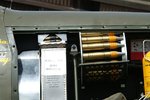Jerry W. Loper
Airman 1st Class
- 121
- Oct 2, 2007
You're the officer in command of a small country's fighter defense squadrons. Let's say the country is Australia and the date is December 1941 or January 1942. The crazy Japanese just bombed Pearl Harbor and are running rampant in the Pacific. For the rest of the war, your squadrons will be provided an adequate supply of American single-seat fighters. The catch is, they'll be either P-39s or P-40s (all the different models of each main type will become available). The responsibility of the squadrons under your command will just be defense of your country, not advancing against Japan. Which type would you pick?

